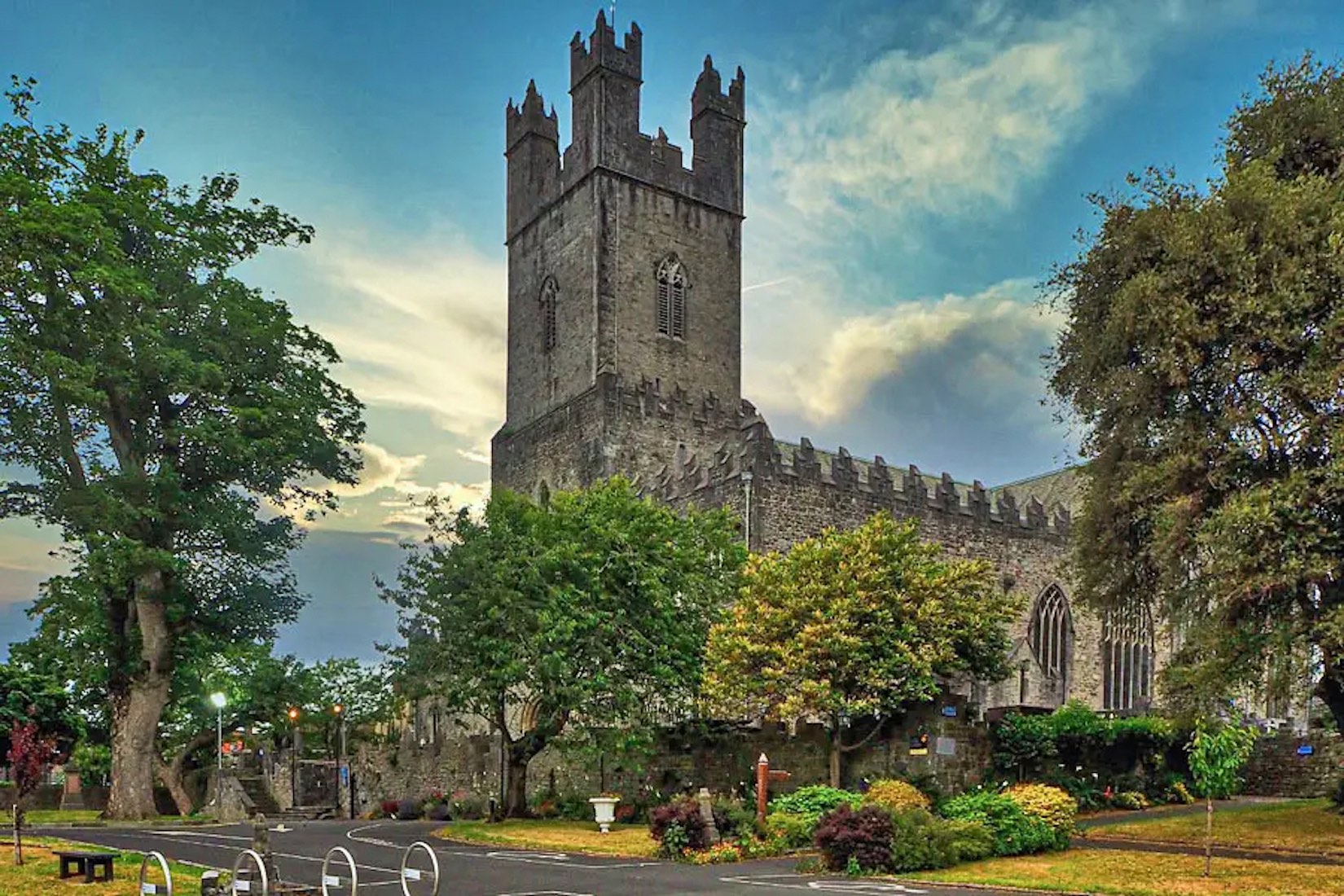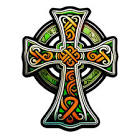This site on St Mary’s Cathedral in Limerick is my second website on Irish cathedrals. The main photographic contributor to this site is ‘Le Monde1’, who has willingly supplied his excellent photographs. Smaller numbers of photos have come from the Cathedral and other sources; these are accredited in the text. in particular, window photographs are almost all from Wikimedia/Gloine. A number of other photos come from Google Street View, and the blog of Patrick Comerford. The initials LM, SMC (Cathedral), WG, GSV and PC will denote our main contributors. I have been delighted at how ready people have been to let me use their excellent photos. Further details about our contributors are given in the Conclusion.
A satellite view, plans, and history of St Mary’s Cathedral are given below. For general navigational purposes you can use the following links:
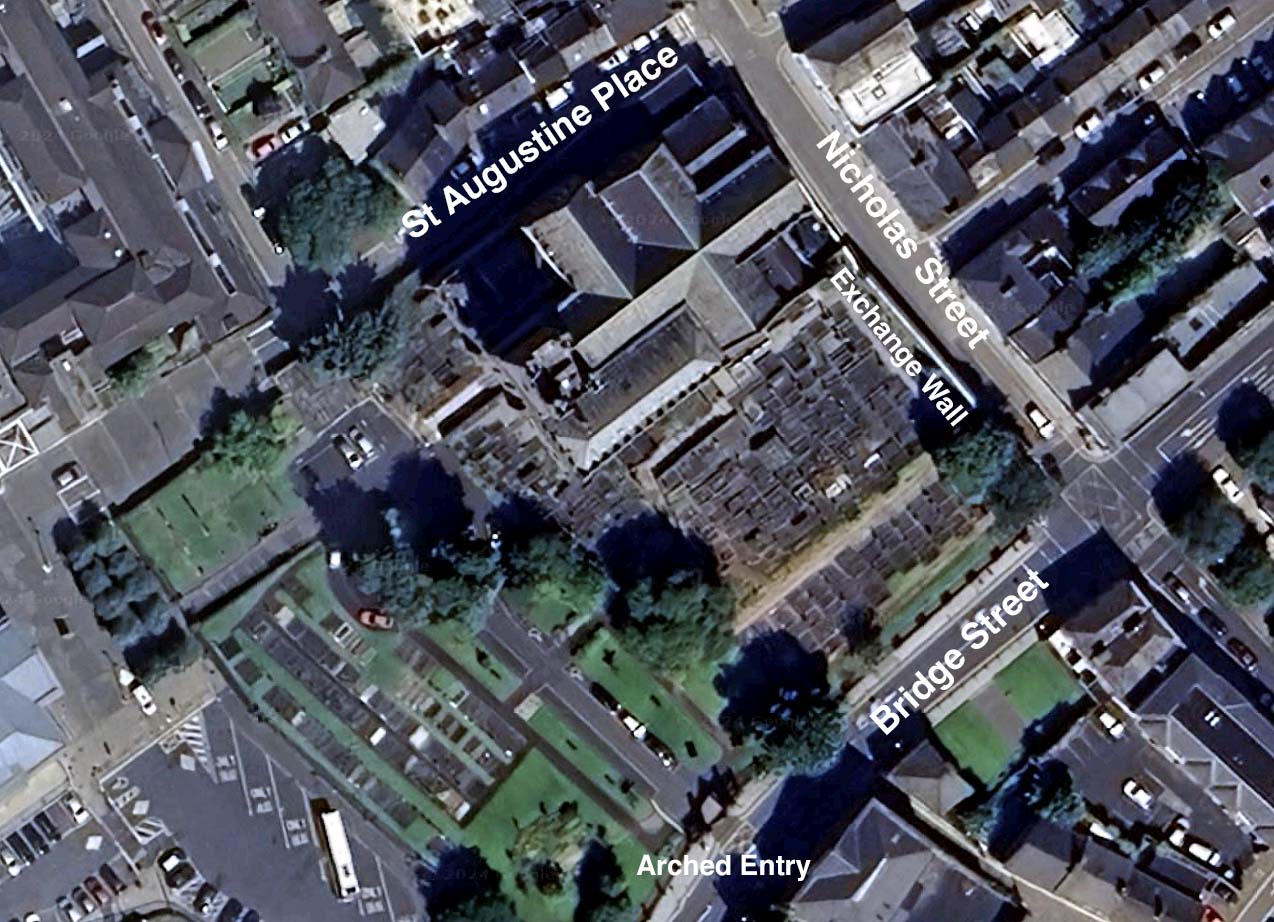
SATELLITE VIEW
From the satellite view we notice that St Mary’s Cathedral is aligned with the street grid. This means that the sanctuary (at the Nicholas Street end) points in a geographical direction close to northeast. In the site we shall follow our usual convention of using liturgical directions, assuming the sanctuary points in an Easterly direction (with a capital E), and other directions are set accordingly.
The Cathedral basically has a cruciform shape with a main East-West axis and North and South transepts. There is also a central square tower at the Western end. However, many chapels and other buildings have been added along the North and South sides, with many of the chapels extending beyond the transepts! The Cathedral is set in spacious grounds, although it is not placed centrally in these. There is a large cemetery to the South, and lawns and car parking to the West. The Exchange Wall along Nicholas Street is an historic boundary feature. Looking carefully we can see that there is a Cathedral entrance (South door) on the South wall at the Western end. This is the main visitors’ entrance.
In exploring the exterior of St Mary’s Cathedral, we shall start near the arched entry on Bridge Street, follow round into Nicholas Street and then left into St Augustine’s Place. We then walk through to the car park at the West end of the Cathedral, follow up to the West door, and then turn right into the cemetery. A brief look at the mausoleum here, and then into the Cathedral through the South door.
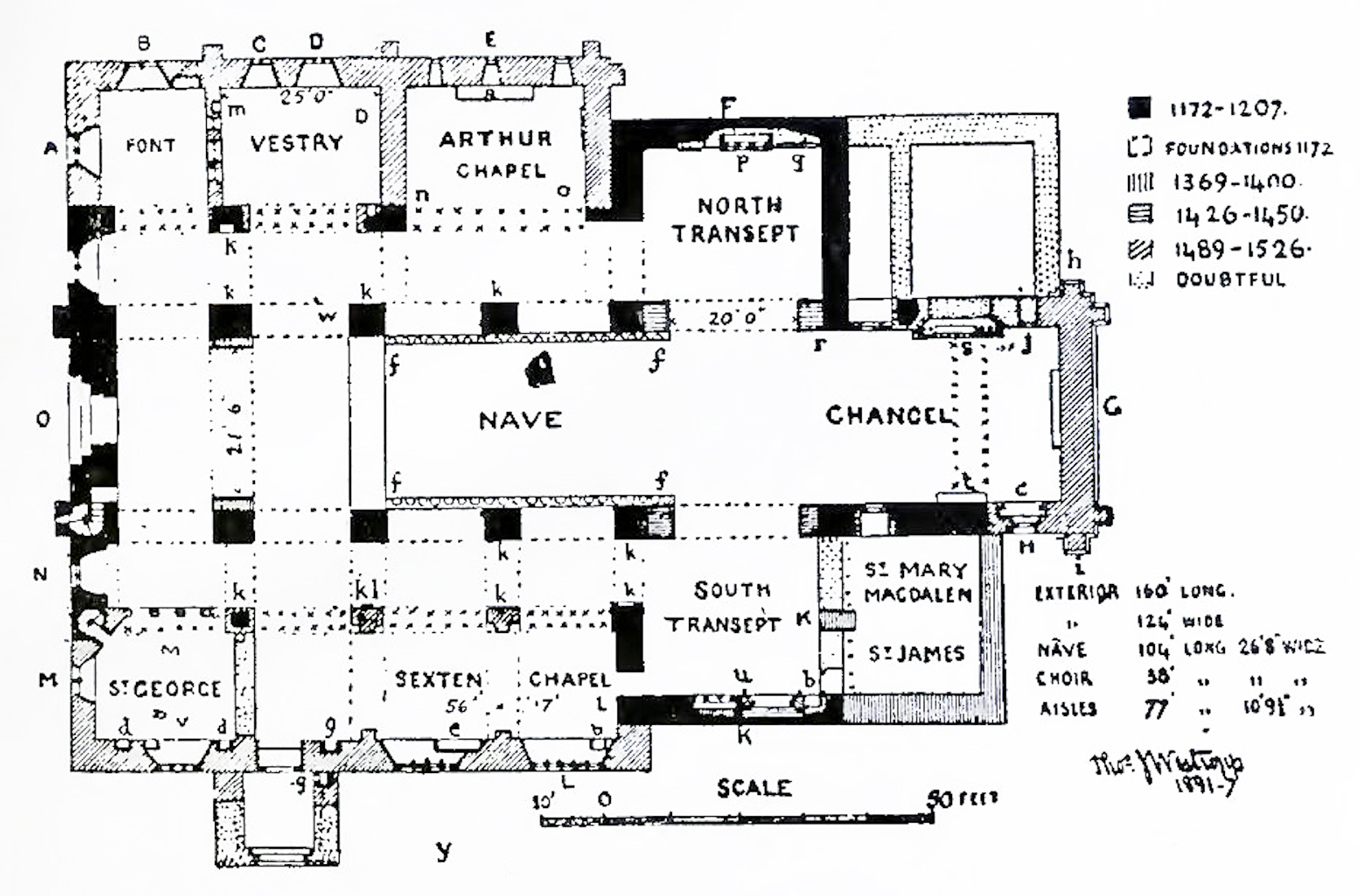
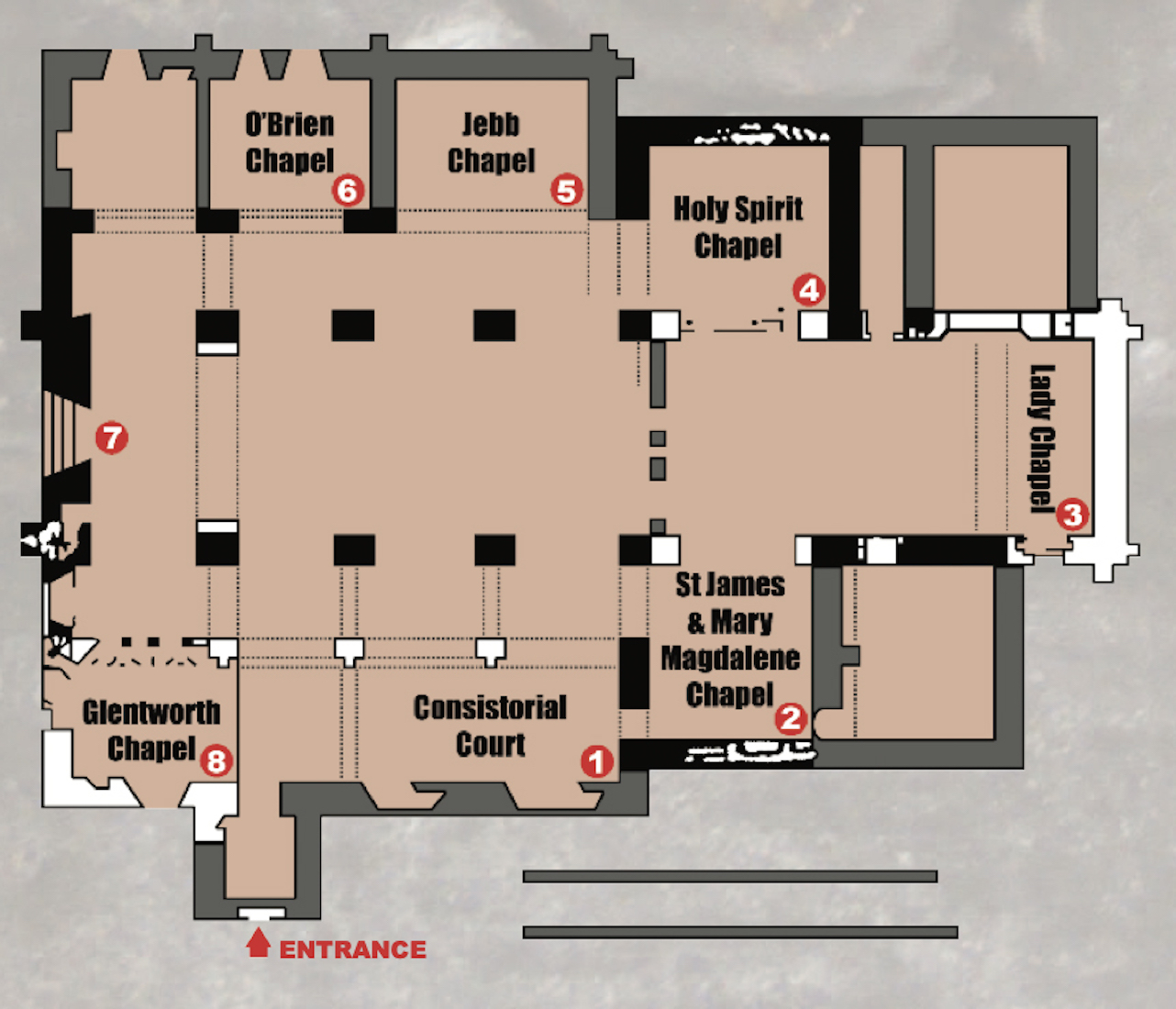
PLAN
Here we find two plans of the Cathedral: an old plan, and a new plan. We shall ignore the various letters and numbers. However, the plans show that nearly every space in the Cathedral has been renamed! This practice complicates our navigation descriptions, and I suspect at the time of writing the Cathedral shop which had been in the baptistry for a time, is now at the Western end of the Consistorial Court – which is now called something else!
In exploring the interior of St Mary’s, we enter by the South entrance, following around the nave and chancel in a clockwise direction.
HISTORY
Wikipedia
Years Built: 1168 –
Address: Bridge Street, Limerick, Ireland
Saint Mary’s Cathedral, Limerick, is a cathedral of the Church of Ireland in Limerick, Ireland, which is dedicated to the Blessed Virgin Mary. It is in the ecclesiastical province of Dublin. Previously the Cathedral of the Diocese of Limerick, Ardfert and Aghadoe, it is now one of six cathedrals in the Diocese of Tuam, Limerick and Killaloe.
From the foundation to the Irish Reformation ...
Limerick Cathedral (Saint Mary’s) is dedicated to the Blessed Virgin Mary and was founded in 1168 and is the oldest building in Limerick which is in use. It has the only complete set of misericords left in Ireland.
In 1111, the Synod of Ráth Breasail decided that ‘Saint Mary’s church’ would become the cathedral church of the Diocese of Limerick. According to tradition, Domnall Mór Ua Briain, the last King of Munster, founded the present cathedral on the site of his palace on King’s Island in 1168. The palace had been built on the site of the Viking meeting place, or ‘Thingmote’ – the Vikings’ most westerly European stronghold. This had been the centre of government in the early medieval Viking city. Parts of the palace may be incorporated into the present structure of the cathedral, most prominently the great west door, which is claimed to have been the original main entrance to the royal palace. The bishops of Limerick have for centuries knocked on this door and entered by it as part of their installation ceremony. According to tradition, during the many sieges of Limerick the defenders of the city used the stones around the West door to sharpen their swords and arrows, and the marks they made in the stonework can be seen there today.
The tower of Saint Mary’s Cathedral was added in the 14th century. It rises to 36.58 metres (120 feet), containing a peal of eight bells, of which six were cast by John Taylor & Co, Loughborough, and two were cast in Whitechapel, London. The tower also contains a stationary service bell, which can be rung from the ground floor.
Notable burials
The cathedral graveyard contains many graves and tombs of notable people. The physician Samuel Crumpe is buried in the graveyard near the great West door. Prince Milo of Montenegro, Frances Condell (first woman Mayor of Limerick) and Bishop Charles Graves are also interred in the grounds. The last High King of Munster, Domnall was purportedly buried in the cathedral, with the remnants of his stone coffin still visible in the Cathedral chancel. Bishop Cornelius O'Dea is buried alongside several other Bishops of Limerick in what is believed to be an Episcopal vault underneath the chancel itself. Also notable are the Sexton, Barrington, Boyd and Vanderkiste tombs along the south entrance pathway.
From the Irish Reformation to the 19th century ...
There are five chandeliers which hang from the ceiling. These are only lit on special occasions. The larger three of the five were made in Dublin and presented in 1759 by the Limerick Corporation. The belfry holds a peal of eight bells, six of which were presented by William Yorke, mayor of Limerick, in 1673. An active team of bell ringers travels the country to compete with other campanologists. Saint Mary’s received its organ in 1624, when Bishop Bernard Adams donated one. It has been rebuilt over the centuries and was most recently renovated in 1968 and 2005.
In 1620 the English-born judge Luke Gernon, a resident of Limerick, wrote a flattering description of the cathedral:
‘not large, but lightsome, and by the providence of the Bishop fairly beautified within, and as gloriously served with singing and organs’.
During the Irish Confederacy wars, the Cathedral was briefly transferred to Roman Catholic hands. The bishop of Limerick, Richard Arthur, was buried in the Cathedral in 1646.
Choir misericords
In 1651, after Oliver Cromwell’s forces captured Limerick, the Cathedral was used as a stable by the parliamentary army. This misuse was short lived, but was a similar fate to that suffered by some of the other great cathedrals during the Cromwellian campaign in Ireland. The troops also removed the Cathedral’s original 4 metre (13 foot) Pre-Reformation high altar. The altar was only reinstated in the 1960s. It is the largest such altar in Ireland and the UK, carved from a single limestone block. The altar is used for communion services at major festivals and remains in its historic location in what is now the chapel of the Virgin Mary or Lady Chapel.
In 1691, the Cathedral suffered considerable damage, particularly on the East end, during the Williamite Siege of Limerick. After the Treaty of Limerick, William granted £1,000 towards repairs. There are cannonball from 1691 in the Glentworth Chapel / Saint George’s Chapel inside.
From the 19th century to the 20th century ...
In 1968, the Irish Government commissioned two postage stamps to commemorate the Cathedral’s 800 year anniversary. In 1991, there was a large £2.5 million restoration programme which was completed in 1996 with the excavation and re-laying of the floors as well as the installation of underfloor central heating. Restoration continues today to a lesser degree.
From the 20th century to the 21st century ...
Today, the Cathedral is still used for its original purpose as a place of worship and prayer for everybody. It is also the third biggest tourist attraction in Limerick. It is open to the public every day from 9:00 am to 4:45 pm. For tourists there is a €5 admission charge upon entry. This money is essential for the upkeep of the building, and without it, the cathedral simply could not function.
Following the retirement of the Very Rev’d Maurice Sirr on 24 June 2012, Bishop Trevor Williams announced the appointment of the Reverend Sandra Ann Pragnell as Dean of Limerick and Rector of Limerick City Parish. She was the first female dean of the Cathedral and rector of Limerick City Parish, and retired in January 2017.
It was announced on 27 August 2017, that the Reverend Canon Niall James Sloane was to become the 63rd Dean of Limerick and the new rector of Limerick City Parish; with his installation and institution taking place on 21 October 2017 in the Cathedral.
The cathedral grounds holds a United Nations Memorial Plaque with the names of all the Irish men who died while serving in the United Nations Peacekeepers.
https://en.wikipedia.org/wiki/St_Mary%27s_Cathedral,_Limerick
